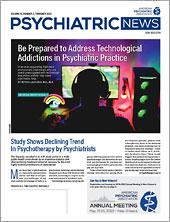As an attending physician at the Pennsylvania Psychiatric Institute’s Child & Adolescent Inpatient Program, Taranjeet Jolly, M.D., has overseen the care of youth with a range of social and emotional issues. During this time, Jolly, who is also an assistant professor of psychiatry at Penn State Health in Hershey, Pa., has also witnessed the psychological and emotional toll that chronic pain can have on children.
While chronic pain is more common among adults, studies estimate that as many as 1 in 3 youth will experience recurring pain symptoms by the end of adolescence. Common symptoms include migraines, abdominal pains, backaches, and limb pain.
“The data also show that pain syndromes are more commonly encountered in clinics in adolescent females than males, but this discrepancy may be because many adolescent boys might not want to report their pain,” Jolly said. Such behavior may lead to underestimates of the number of youth experiencing chronic pain, he added.
Chronic pain in children and adolescents can lead to a host of problems for the youth and their families, he continued. “The children typically experience school difficulties from the ongoing pain and resulting poor sleep, while parents are constantly leaving work to help with doctor’s visits or taking care of the child.” Pain can lead to such problems as depression, anxiety, and loss of self-esteem. These symptoms, along with reductions in physical activity, can lead to obesity, which can further lower children’s self-esteem, Jolly added.
The economic impact of pediatric pain on families can also be significant. One analysis suggested that the average cost of living for a family with a child with chronic pain can be significantly higher than that of families with a child not experiencing these symptoms. This stems from the direct cost of medical care that they seek, as well as parents’ economic losses.
Early intervention is critical when treating youth with pain, but few physicians are trained to provide this care, Jolly said. As a result, it may take up to three years for children to see a pediatric pain specialist, and they might see five different physicians before seeing a pediatric pain specialist. This might lead to a significant delay in addressing the physical and emotional burden from chronic pain leading to mental health issues such as anxiety or depression.
Given the strong connection between physical and emotional pain, Jolly believes that psychiatrists can play a role in closing this treatment gap by screening youth for chronic pain and helping patients manage this pain and other comorbidities.
There are only a few pharmacological guidelines on treating youth with pain, and available ones have very limited data, Jolly said.
He recently conducted a meta-analysis involving four psychotropic medications with clinical evidence of reducing symptoms of pediatric chronic pain: the tricyclic antidepressant amitriptyline, the serotonin-norepinephrine reuptake inhibitor duloxetine, the selective serotonin reuptake inhibitor citalopram, and the anti-anxiety drug buspirone.
While there were only five studies included in the analysis, the findings pointed to the effectiveness of amitriptyline, duloxetine, and citalopram in pediatric pain management, with amitriptyline showing the strongest effect.
Jolly cautioned that patients can experience side effects while taking amitriptyline and other tricyclics so it’s important to start patients at low doses and carefully monitor them. “Compared with the other three medications, the buspirone data were the least robust, so it’s hard to make a case to use it as a monotherapy,” he added.
Regardless of the antidepressant prescribed to youth, the data suggest it can take as long as 12 to 13 weeks to see significant reductions in the intensity of children’s pain, Jolly said. This time frame is different from that of adults—some patients report pain improvements as early as one week after treatment.
One theory Jolly offered as to why it can take months before youth experience pain relief from antidepressants is that the improvement in chronic pain may be secondary to decreased anxiety, improved mood, and functioning, which typically take six to eight weeks of treatment. Studies have shown that children and adolescents—particularly females—exhibit strong correlations between their levels of physical pain and their how they are feeling emotionally.
Studies have shown that chronic stress can rewire the neural connections in the brain’s pain centers, he explained. “After a while of dealing with pain, the mood and pain circuits become a two-way channel; if you are having a rough day, your brain [responds] much in the same manner as if you are experiencing physical pain. This can make you sensitive to future pain sensations just as pain makes you more sensitive to the effects of stress.”
Understanding whether psychotropics offer primary pain relief in children is important, since it will guide treatment selection, Jolly noted. It can be tempting to pick a medication like amitriptyline for youth with co-occurring depression and pain since it may offer a two-for-one way to manage symptoms. But depending on the history and other clinical features, it might be prudent to find the best option for their depression symptoms first.
Other options for pain relief that are commonly used in children are NSAIDS (non-steroidal anti-inflammatory drugs) and the anticonvulsants pregabalin and gabapentin; Jolly said the latter two agents should be dosed with extreme caution as children metabolize these drugs differently from adults. He does not recommend using opioids or cannabis, as he does not believe that the benefits of these drugs outweigh the potential risks of their use.
“And don’t forget that optimal pain care requires behavioral and physical interventions in addition to pharmacological care,” he said. Several studies have demonstrated that cognitive-behavioral therapy, pain education, and mindfulness-based techniques are effective in children experiencing pain. Psychiatrists should also be aware of how physical therapy, yoga, and acupuncture might help young patients experiencing pain.
“I strongly believe psychiatrists, along with other primary care physicians such as pediatricians, should become more active in pediatric pain management,” said Jolly. ■
“Are Psychotropic Medications Effective in Chronic Pain Management in Children and Adolescents? A Meta-Analysis of Randomized Control Trials” is posted
here.

